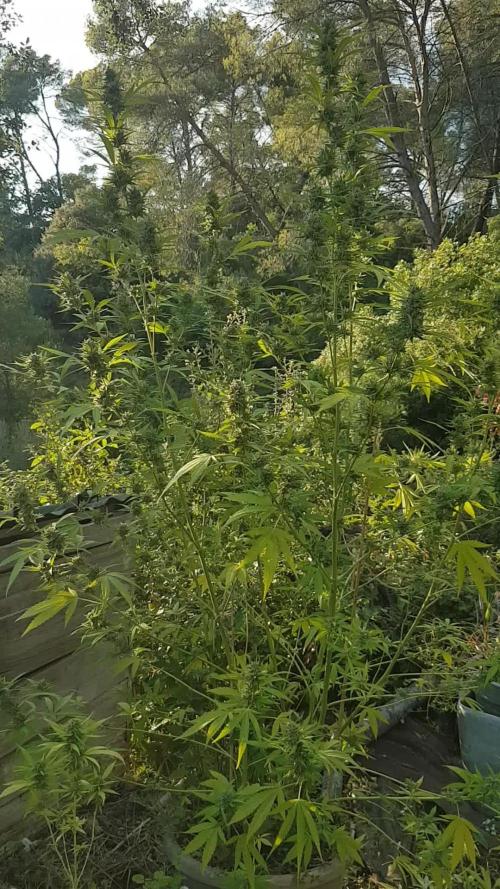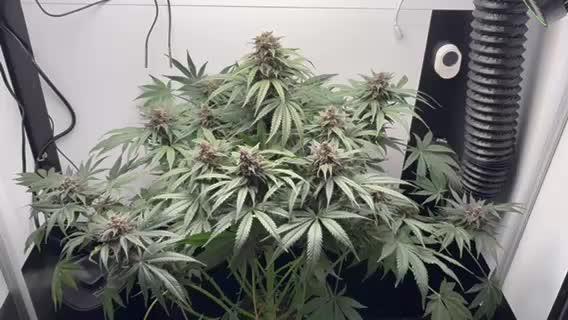The Grow Awards 2026 🏆 





























Likes
14
Share


@TherealNICOGREEN
Follow
Er lige blevet plantet over i 4 liter potte , tilsat PLAGRON bat pouder 💚👍🧡🖤💚👌plus hun er blevet flyttet uden for samme med resten af hendes familie:-), som er hastigt på vej til at blive nogle gode dagbøger. Hun har overlevet sin første nat nu og har det rigtig godt. 👍 godt hun strutter af sundhed:) jeg skal have ryddet op, så jeg får mere plads til mine piger. Jeg har en ok terrasse der bare lige skal ryddes lidt op i og fejes. Det bliver RIGTIG GODT 😊.
Likes
5
Share


@Benssa
Follow
Starting the week defoliating the babies, hopefully, they'll get more light penetration and recover in the pre-flowering phase, I think two more weeks until flowering stage.
Likes
30
Share


@420DeepGrow
Follow
Gracias al equipo de MSNL Seeds, Marshydro XpertNutrients y Trolmaster sin ellos esto no sería posible.
💐 🖊️Permanent Marker:
Ganadora del premio "Cepa de hoja del año" del año pasado, es justamente eso: uno de los mejores híbridos de la nueva escuela que jamás haya adornado los cuartos de cultivo de los conocedores. Su perfil de sabor es nada menos que celestial, y su efecto es tan bueno como parece: ¡un híbrido verdaderamente equilibrado que es el epítome de lo que agrada al público!
🚀🌻 Consigue aquí tus semillas:
https://www.marijuana-seeds.nl/permanent-marker-feminized-seeds
💡FC6500: Eficiencia líder en el mercado: la lámpara de cultivo LED FC-E6500, que ostenta un estatus líder en el mercado, es una solución rentable con un PPE de 2,8 µmol/J y un rendimiento máximo de 2,5 g/vatio. Ofrece un PPF alto de 2026 umol/S y es adecuada para una cobertura de vegetación de 1,50 m x 1,50 m y una cobertura de flores de 1,20 m x 1,20 m.
Iluminación versátil y uniforme.
https://marshydro.eu/products/mars-hydro-fc-e-6500-730w-commercial-led-grow-light/?gad_source=1&gclid=Cj0KCQjw1qO0BhDwARIsANfnkv9IIrYSbmJqz8PqpJOIyWwJfp5bc3SGJgUV68USLQ4tjmXDYwoBuAsaAue3EALw_wcB
🚥 MarsHydro ADLITE UV/IR/RED:
Para lograr un crecimiento óptimo de las plantas y maximizar los rendimientos es un arte simple que depende en gran medida de las condiciones ambientales adecuadas. Reconociendo las limitaciones de la iluminación natural y las soluciones de iluminación tradicionales para satisfacer estas necesidades únicas, lanzamos ADLITE. Estas luces especiales UV, IR y roja están diseñadas para llenar áreas del espectro, proporcionando las altas longitudes de onda que las plantas necesitan para un crecimiento y desarrollo óptimos.
Consigue aqui tu Adlite:
https://marshydro.eu/collections/adlite-supplemental-lights/
🏠 : Marshydro 1.50 x 1.50 x 1.80, carpa 100% estanca con ventanas laterales para llegar a todos los lugares durante el grow
https://marshydro.eu/products/diy-150x150x200cm-grow-tent-kit
🌬️💨 Marshydro 6inch + filtro carbon para evitar olores indeseables.
https://marshydro.eu/products/ifresh-smart-6inch-filter-kits/
🍣🍦🌴 Xpert Nutrients es una empresa especializada en la producción y comercialización de fertilizantes líquidos y tierras, que garantizan excelentes cosechas y un crecimiento activo para sus plantas durante todas las fases de cultivo.
Consigue aqui tus Nutrientes:
https://xpertnutrients.com/es/shop
📆 Semana 8:
Gran semana, el engorde de los cogollos se ha notado de forma considerable, las plantas tienen una gran capa de resina y estan listas para su última etapa antes de pasar a una mejor vida.
El olor es tan fuerte a marcador permanente que al filtro le cuesta disimularlo. Dejo de aplicar nutrientes ya que no lo van a necesitar mas, agua hasta el final.
Potencia del foco 90%.
Likes
2
Share


@secretcedar
Follow
Day 132
It's been much cooler this week, and the plants are using much less water.
I'm wondering whether to harvest it on Tuesday or wait another week.
A little rain is forecast, but it should be very light.
I thought the buds would get bigger, but that's not happening.
The buds are really loaded with big trichomes.
Otherwise,
I've defoliated to allow the smaller, lower buds to grow bigger.
Likes
18
Share


@RADE245
Follow
Just watered it once this past week. About a small water bottle's worth on Tuesday. Watered it earlier today (Saturday, May, 2). This is the beginning of the second week. The weather will be hot so I am going to be watering a bit more frequently, but smaller amounts. I typically start watering every other day around this time of year because the temperature will start to pick up to high 70s, early 80s. This week the temperature went up to 97 degrees fahrenheight or 36° celsius. The background plants I've been developing in the video have been growing since December 9th, no lie...I thought they were going to die because of the cold, buy there they are.
Likes
12
Share


@DrShotzUK
Follow
Week 10 / 11
Starting the flush smells absolutely amazing
Big thanks to 420 fast buds for the seeds.
DRSHOTZUK💚💚🍀🍀
Likes
11
Share


@Novagrow
Follow
This stuff has taken an age to dry! I think it was a little too cool in the tent. ah well.
Its currently in jars curing, so havent had chance to try it out and i think im prepared to give it a full 6 weeks of cure.
Results wise, little disappointed by the yield, only 4oz but it was a micro grow - I think perhaps although i didnt notice it at the time, the heatwave fortnight i had during flower may have had something to do with the lack of growth - but still the quality of the buds is high, plenty of trichomes and buds are really dense.
As its still in cure its still a bit hay-smell as the chlorophyll continues to work its way out but there are lovely undertones of gas and fruit - (cherry?)
Will check back in with a smoke report in a few weeks but wanted to get a couple of vids of the buds (yes i dont trim them like the pros, i dont care :p )
Likes
11
Share


@Sechlaw
Follow
Everything is good the smell is starting to getting so sweet ! Critical Mass is getting fluffy, frosty and soooo sticky !! Chocolate Haze is packing big long buds, can't wait !!!
Ps : Sorry for the mess in the order of the pics ! 😅
Likes
15
Share


@AK1210
Follow
This week has been a good one all round. The sun has been beaming down all day for days and I still due to continue for a while. The gorilla 🦍 has now started to get to a nice bushy size, unfortunately outgrowing the original tent position. After the mistake I made with the Rhino Ryder I grew by taking the bold move to leave permanently in the elements, the cold temps at night really slowed bud production. I have had to improvise and make a shoddy attempt at lifting the tent to allow the room needed.
Likes
24
Share


@Seedler
Follow
i used a low dose because for my plants even half strength is often too much, this saves nutrients tho.
Around 825ppm, 18 DLI, Ph 6-6,25
thanks to FastBuds and Terra Power!
Likes
3
Share


@123Grow
Follow
1. LABS - I suggest using distilled water for the entire process ( no chlorine or chloramine). I also suggest the type of rice product shown ( 1/2 cup), it has red, brown, white, and black rice blended together. You get the benefits of each type.
2. Take the rice that was used in making the rice rinse for labs and boil it in 3 cups of water for 30 mins. Strain the rice out. Add 1 TBSP molasses per 300 mls.
Use 300 mls of the above mixture during your watering cycles. It contains starches, b vitamins, aminos, trace minerals, calcium, magnesium, iron, phosphorus, potassium, and some nitrogen. The ppm’s are not higher than 200 ( if using distilled water). This is ONLY used if your plants are healthy. If your plants are sick…this will NOT help them. It will make stuff worse!!!
The Hulk-Berry got a new home. 1 tsp 7-3-1, 1/2 tsp 0-12-0, 1/2 tsp Langbeinite, 1 TBSP 2-2-2, 3 TBSP 4-3-3, worm castings, recharge (1/32 tsp) into the soil ( Mother Earth).
The 3 RuntZ are coming back from slow growth at the outset. I added LABS, Lentil SST, Photosynthesis Plus to the media. I did a foliar spray with recharge. 24-36 hours later the leaves exploded with growth and height. I added ZERO nutrients!!! I only used natural inputs and bacteria to get the root zone back in order.
11-3. Things are all in check! The LABS, SST’s and Rice wash have gotten the 3 RuntZ back on track. The Hulkberry is in full swing. I think I can get to 3 feet by flower time with the Hulkberry
11-5 All is well today!!! Everyone is very happy after the cal-mag, Photosynthesis Plus, kelp bath
Likes
17
Share


@CCSAUTOVGROW
Follow
Purple Pheno!!!!!!!!!!!!!!!!!!!!!
Ripening nicely. She is super smelly. Smells like fruity gape. Have 2 carbon filters going and it doesn't even touch the smell. Noticed a little burn on the tips of the leaves so backed off a little on the nutes. Coasting toward the finish line. Maybe three weeks?😁
Likes
9
Share


@DeepRootsGrowTrees
Follow
KICKASS AUTO by KANNABIA
Week#7 May 14th-21st
Week #2 Flower
This week she stretched about 2 inches she's right at 19 inches she also continues to grow side branches she really a nice looking bushy plant. Dark green color trichomes are starting to form on her buds and leaves and she's starting to fill in you can see the white hairs and start off little buds on her. She is doing great outside!! Stay Growing!!
Kannabia.com Kickass Auto
Processing
Likes
52
Share


@HazeyBobby
Follow
The week starts Monday Jan-27, being day 27 of flowering.
Plants are looking very good and healthy, albeit some bigger buds at this stage is missing.
Carried out more minor defoliation, only trimming fan leaves on one side of a bud site in alternate fashion. Strategy is to expose more bud sites to light. Leaves are getting sticky and glistening brightly.
The canopy has a few branches stretching out typical of Sativa genetics. Hoping the bud sites grow bigger soon filling up the space.
Feeding a high EC nutrient mix whilst monitoring run-off EC which remains below feed EC.
Light is maintained at 30cm above the canopy, with daily fertigation at lights on - watering just under 3L per day. Maintaining an average RH in the space at 50%.
---- updates for prior 4 weeks --------------------------------------------------------------------------------------------------------------------------------------------------------------------------------------
-----------------------------------------------------------------------------------------------------------------------------------------------------------------------------------------------------------------------
The week starts Monday, Jan-20 still flowering away.
Bud sites are beginning to take form and the ScrOG setup looks full, ready for the development of some large buds.
Removed a few more leaves from above the canopy which were blocking bud sites below. Also cut small stems (with bud sites) below the canopy from both plants which were unlikely to grow strong. It's now looking clearer below the canopy.
The canopy is still thick with beautiful luscious green leaves typical of an Indica. Run-off EC has been slowly rising over the weeks but still under the feed EC - will be keeping my eyes on this.
Light is maintained at 30cm distance from canopy, with daily fertigation at lights on - watering almost 2.5L per day. Maintaining an average RH in the space at 50%.
-----------------------------------------------------------------------------------------------------------------------------------------------------------------------------------------------------------------------
The week starts Monday, Jan-13 in flowering stage.
The plant is growing thick and fast, with very short node intervals creating a thick canopy.
Carried out substantial defoliation of almost all the big fan leaves and a few little stems that were not likely to make it above the canopy. Avoided defoliating the major cola branches. This encourages the plant not to waste resources on a node which is only going to produce “popcorn” buds.
The plants reacted well to the defoliation and were looking good by the end of the light cycle for the day. The net is completely full and this will be the last week of applying any LST as part of the ScrOG setup.
Light is maintained at 30cm distance from canopy, with daily fertigation at lights on - watering almost 2.5L per day. Lowered the average RH in the space to 50%.
-----------------------------------------------------------------------------------------------------------------------------------------------------------------------------------------------------------------------
The week starts Monday, Jan-06 in flowering stage.
The net is filling up nicely with the ScrOG process being enjoyable - just tucking branches nicely under squares once stretched enough. The Indica dominant strain is really shining with incredible dense growth and thick branches that don't bend as easily as it's Sativa neighbour.
Light is maintained at 30cm distance from canopy.
-----------------------------------------------------------------------------------------------------------------------------------------------------------------------------------------------------------------------
My grow setup includes;
- Secret Jardin DS120W tent (120cm x 60cm x 180cm) placed inside the bedroom. Passive intake of air is from a closed off section of the room where the central heating boiler sits - the intake is warm air (20 degC.) and fairly dry (40% RH) during the winter months.
- Mars Hydro SP250 LED light
- extraction fan - AC Infinity Cloudline T6
- ventilation fans
- aquarium heater
- small oil heater
- small dehumidifier
- 20L Airpots and 3.5L general pots for seedling stage
- Canna Coco substrate and nutrients
- pH and EC/TDS meters
- Thermo/Hygro meter
Likes
4
Share


@Xabii
Follow
The seeds that I thought I found were a false alarm, looked a lot like seeds built up and was super hard in texture but this week it popped and it was just some weird foxtailing I guess.
Trichomes are about 20% clear 60-70% milky and very few ember.
Very certain that I will chop her next week, this time for real.
This grow is a rollercoaster of emotions, that is for sure.
Values are average of the day.
DATE - EC(us/cm)
20250604 1559
20250605 1588
20250606 1610
20250607 1630
20250608 1654
20250609 1668
20250610 1722
DATE - PH
20250604 5.86
20250605 5.86
20250606 5.85
20250607 5.85
20250608 5.85
20250609 5.85
20250610 5.86
DATE - ORP (mV)
20250604 151
20250605 217
20250606 241
20250607 248
20250608 237
20250609 235
20250610 224
DATE - °C - RH% (Tent Temp/RH)
20250604 25.6 48
20250605 25.4 53
20250606 25.2 53
20250607 24.7 55
20250608 24.5 54
20250609 24.2 48
20250610 24.8 52
DATE - °C (Reservoir)
20250604 21.5
20250605 21.5
20250606 21.3
20250607 21.0
20250608 20.8
20250609 20.2
20250610 20.8
DATE - CF
20250604 15.59
20250605 15.88
20250606 16.10
20250607 16.30
20250608 16.54
20250609 16.68
20250610 17.21

























